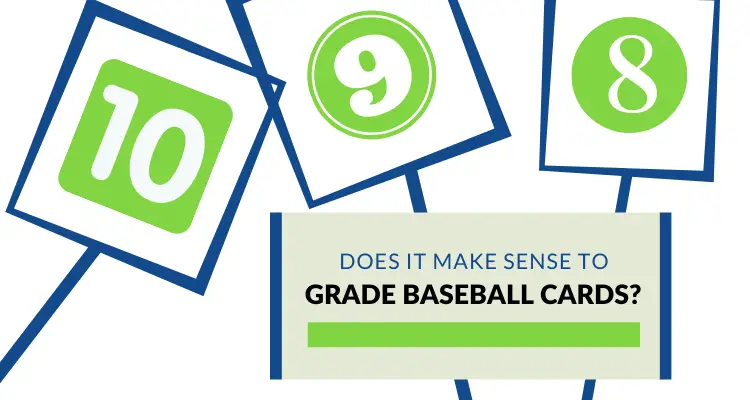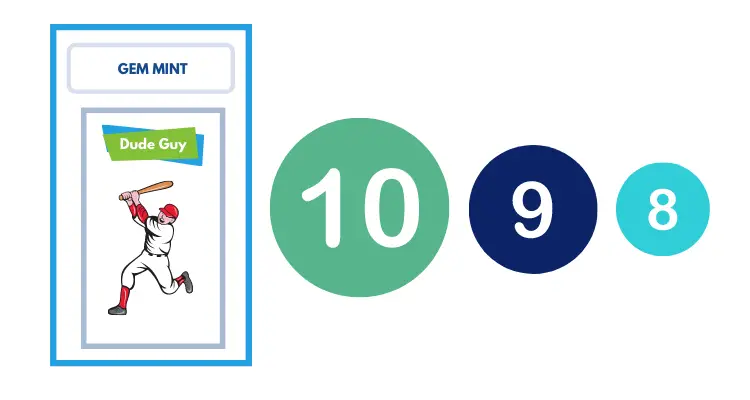Affiliate Disclosure: This post contains affiliate links. As I am a part of the eBay Partner Network and other programs, if you follow these links and make a purchase, I’ll receive commission. As an Amazon Associate, I earn from qualifying purchases.
I’ve been writing about PSA and BGS for a long time—let me be clear: there is no “best” grading company. Meaning, the choice between PSA, BGS, or any other option is highly personal and depends on your individual circumstances, preferences, and goals for your cards.
That said, there are differences between PSA and BGS, and if you want to talk about what the market tends to favor, it’s PSA, both in terms of the number of cards graded and resale value.
March ’23 Grading Recap
— GemRate (@gemrate) April 2, 2023
Overall grading activity was up 19% vs Feb
— PSA graded 1.22m cards (+22% vs Feb)
— SGC graded 121k cards (+31%)
— CGC graded 84k cards (-17%)
— Beckett graded 71k cards (+11%)
— CSG pop report is still under maintenance#sportscards #tradingcards pic.twitter.com/1yCCxzbuQO
(As you can see here from GemRate, PSA graded 1.22m cards in March 2023, compared to 7k by Beckett.)
A “10” in PSA terms is different than a 10 in BGS terms. Meaning, a BGS 9.5 is considered “gem mint” and a BGS 10 could either be “pristine” or can earn the “black label” for subgrades of “10” for each of the four major grading factors.
With modern cards, take a look at the difference between a raw card and a PSA 9 and PSA 10 of that same card:



How often does this hold true? It’s going to differ between every card and will vary depending on time of year and other factors.
So, the best thing you can do is to look at eBay completed sales to get a sense for what a card in a particular PSA grade has sold for compared to its raw counterpart, or more to the point of this article, compared to its BGS counterpart.
(Just to tie off this point, here is what that same Curry Upper Deck rookie card has sold for recently in a BGS slab:)



As an important note, a BGS 10 Black Label is far more elusive than a PSA 10. Thus, when comparing top grades of “gem mint,” most will do so between a PSA 10 and a BGS 9.5. You can see that reflected above, and here below:
- Raw: $149.99
- PSA 9: $250
- BGS 9.5: $318
- BGS 10: $731
- PSA 10: $806
- BGS Black: $3,550
Another interesting note is that it’s more common to see a PSA 10 than a BGS 10, probably due to the fact that BGS awards the 9.5 half-grade and PSA doesn’t. But, from the above and at least in this case, a PSA 10 might be worth the same if not more valuable in some cases. We have more comparisons below.
Reader Email: Shaun S., asks “Would you use Beckett or PSA to have cards graded?”
Between PSA and Beckett, will you be selling or keeping the cardsafter you grade them? If keeping, it’s really just a preference of slab and how much you want to spend. If selling, PSA typically has a better resale value, but with caveats when it comes to the BGS 10.
Value Comparisons
How does PSA compare to BGS in terms of slab value?
Again, I’ll reiterate that comparisons are going to differ card by card, day by day. The best I can do is list out the information I’ve uncovered, but please take it with a grain of salt, and think through the time of year, player, type of card, and more. I’ll try my best to keep adding to this list, while attempting to include different types of cards, from vintage and modern, to vet and rookie.
This is not guidance, and the information here is solely for informational purposes. All I’m doing is pulling data from eBay completed sales so I encourage you to double-check for errors, etc. This eBay data comes from the last 365 days, and I’m only including the most recent sale I see, so obviously if a card was sold 364 days ago in a BGS slab, the value might be much different today regardless of what slab it is in.
TLDR, please draw your own conclusions!
| Card | PSA 10 | PSA 9 | BGS 10 Black | BGS 10 | BGS 9.5 | Raw | eBay |
|---|---|---|---|---|---|---|---|
| 2009 Upper Deck Stephen Curry #234 | $806.00 | $250.00 | $3,550.00 | $731.00 | $318.00 | $149.99 | Check eBay |
| 1989 Upper Deck Ken Griffey Jr. #1 | $1,850.00 | $209.99 | NA | NA | $752.00 | $45.00 | Check eBay |
| 1986 Topps Jerry Rice #161 | NA | $2,600.00 | NA | NA | $6,706.00 | $42.00 | Check eBay |
| 2019 Select Premier Silver Ja Morant #120 | $245.00 | $144.19 | NA | $650.00 | $278.00 | $142.51 | Check eBay |
| 2018 Bowman's Best Juan Soto #29 | $40.00 | $15.50 | $460.00 | NA | $20.50 | $7.58 | Check eBay |
| 2018 Topps Chrome Ronald Acuna | $65.00 | $38.00 | $761.00 | $147.50 | $69.00 | $25.00 | Check eBay |
| 2012 Prizm Silver Anthony Davis #236 | $3,801.00 | $504.00 | $1,426.99 | NA | $895.00 | NA | Check eBay |
| 2022 Donruss Marvels Tom Brady | NA | NA | NA | $1,200.00 | NA | $276.00 | Check eBay |
| 2022 Topps Cosmic Chrome Julio Rodriguez #197 | $142.50 | $35.45 | $965.00 | NA | $139.75 | $49.00 | Check eBay |
PSA
Since its inception, PSA has become one of the most widely recognized and respected grading companies in the hobby. The company has also expanded its services beyond sports cards to include autographs, tickets, packs, and more.
Grading Scale
PSA’s grading scale ranges from 1 to 10, with half-grads included for added precision (just not including 9.5). The scale is as follows:
- PSA 1 Poor
- PSA 1.5 Fair
- PSA 2 Good
- PSA 2.5 Good+
- PSA 3 Very Good
- PSA 3.5 Very Good+
- PSA 4 Excellent
- PSA 4.5 Excellent+
- PSA 5 EX (Excellent)
- PSA 6 EX-MT (Excellent-Mint)
- PSA 7 NM (Near Mint)
- PSA 8 NM-MT (Near Mint-Mint)
- PSA 9 MINT
- PSA 10 GEM MINT
In terms of what this means, and the differences between the grading levels (like a PSA 10 vs a BGS 9.5):
Here you can see the progression from worst to best, a PSA 10 1952 Mickey Mantle with photos pulled from psacard.com.

Understanding the grading scale is important as it helps collectors determine the value of their cards. By knowing the condition of a card, collectors can make informed decisions when buying or selling.
Fees & Turnaround Times
PSA offers a range of services that cater to collectors and dealers alike. Whether you’re looking to grade a single card or submit a large collection, PSA has options. Each service level comes with its own set of benefits, turnaround times, and fees, so let’s take a look at how much it costs to grade a card with PSA.
| Service Level Name | Price Per Card | Declared Value | Turnaround Time |
|---|---|---|---|
| Value Bulk | $10 | N/A | 20 business days |
| Value | $20 | Under $500 | 20 business days |
| Value Plus | $25 | Under $1,000 | 15 business days |
| Regular | $50 | Under $2,500 | 10-15 business days |
| Express | $100 | Under $5,000 | 5 business days |
| Super Express | $200 | Under $25,000 | 2 business days |
| Walkthrough | $600 | Unlimited | 1 business day |
It’s worth noting that PSA also offers additional services, such as reholdering for a fee and crossover. You can find more information on the links provided, but quickly, reholdering is the service if you want your PSA slab replaced, and a crossover is when you submit a card already graded by another company for grading bt PSA.
Beckett
Beckett Grading Services, or BGS for short, is another well-respected grading company in the sports card industry. BGS was founded in 1999 and is a division of Beckett Media, a company that has been around since 1984 and is known for its various sports card price guides and publications.
Grading Scale
BGS uses a similar grading scale to PSA, with a range of 1 to 10, with half-point increments. However, BGS also uses a subgrade system that grades the individual components of a card, including the centering, corners, edges, and surface. The subgrades are then averaged to determine the final overall grade of the card.
The BGS grading scale is as follows:
- Pristine 10
- Gem Mint 9.5
- Mint 9
- Near Mint/Mint 8
- Near Mint 7
- Excellent Mint 6
- Excellent 5
- Very Good/Excellent 4
- Very Good 3
- Good 2
- Poor 1
Raw Card Review
The BGS grading process is also similar to PSA, with a multi-step process that includes authentication, grading, and encapsulation. However, BGS also offers a service called Raw Card Review (RCR), which allows collectors to have their raw, ungraded cards reviewed by BGS experts for a fee.
Why should you Raw Card Review before grading?
— JB (@OldTownCards) December 14, 2022
The difference between a 9 and 10 can be huge. With Flair I saw $15 in a 9 vs $200 in a 10. By doing RCR I was able to 80%+ gem these cards and really do well with that set. pic.twitter.com/ddtU940zFI
The experts provide feedback on the condition of the card and offer grading estimates, which can help collectors decide whether or not to get the card graded.
Fees & Turnaround Times
In terms of fees and BGS turnaround times, Beckett offers various service levels with different pricing. The pricing varies based on the declared value of the card, with higher declared values costing more to grade. BGS also offers a bulk submission option for those with larger collections.
| Service Level Name | Price Per Card | Declared Value | Turnaround Time |
|---|---|---|---|
| Relabel | $10/card | $10/card without subgrades | 10-15 business days |
| Collectors’ Special | $18/card | $16/card without subgrades | 40-60 business days |
| Base | $22/card | $18/card without subgrades | 40-60 business days |
| Standard | $40/card | $40/card without subgrades | 10-20 business days |
| Priority | $140/card | $100/card without subgrades | 2-5 business days |
| Next Day | $400/card | $400/card without subgrades | 1 business day |
| Immediate | $500/card | $500/card without subgrades | Same day |
Overall, BGS is a popular choice for collectors who value the subgrade system and appreciate the additional service options offered by the company.



